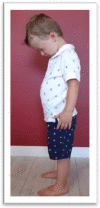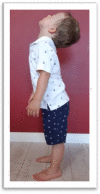Primitive Reflex Activity in Relation to Motor Skills in Healthy Preschool Children
- PMID: 34439585
- PMCID: PMC8394673
- DOI: 10.3390/brainsci11080967
Primitive Reflex Activity in Relation to Motor Skills in Healthy Preschool Children
Abstract
Psychomotor development in the first year of life is possible due to activity and then integration of primitive (neonatal) reflexes. The presence of active primitive reflexes (APRs) in preschool and school-aged children indicates neuromotor immaturity. Studies show dependencies between the preserved activity of primary reflexes and developmental problems such as learning difficulties (problems with reading, writing, reduced mathematics skills, and dyslexia), difficulties with coordination, and attention deficit. The primary purpose of this study is to present the activity of three tonic reflexes in a sample of 112 Polish children aged 4-6 in relation to their motor skills. The children were examined for the presence of the asymmetric tonic neck reflex (ATNR), symmetric tonic neck reflex (STNR), and tonic labyrinthine reflex (TLR). Motor performance was examined with the MOT 4-6. Statistical analysis shows an inverse correlation between the score in the test of reflexes and motor efficiency (MOT 4-6) at p < 0.05 (-0.33). Children with increased reflex activity presented a lower level of motor efficiency. The multiple regression model showed that with the older age of the child and the decrease in the level of reflex activity, the motor skills of children improve. Thus, there is a need for early screening of primitive reflexes in children. Properly selected exercises and therapeutic activities aimed at integrating APRs in children with developmental difficulties can improve their motor skills, perceptual abilities, and emotional behavior.
Keywords: neuromotor maturity; physical development; preschool children; primitive reflexes.
Conflict of interest statement
The authors declare no conflict of interest.
Figures








References
-
- Hickey J., Feldhacker D.R. Primitive reflex retention and attention among preschool children. J. Occup. Ther. Sch. Early Interv. 2021 doi: 10.1080/19411243.2021.1910606. - DOI
-
- De Jager M. Sequence of Primitive Reflexes in Development. Mind Moves Institute; Johannesburg, South Africa: 2009.
-
- Sigafoos J., Roche L., O’Reilly M.F., Lancioni G.E. Persistence of Primitive Reflexes in Developmental Disorders. Curr. Dev. Disord. Rep. 2021 doi: 10.1007/s40474-021-00232-2. - DOI
-
- Goddard Blythe S., Duncombe R., Preedy P., Gorely T. Education 3-13: International Journal of Primary, Elementary and Early Years Education. Taylor&Francis Online; London, UK: 2021. Neuromotor readiness for school: The primitive reflex status of young children at the start and end of their first year at school in the United Kingdom. - DOI
LinkOut - more resources
Full Text Sources
Medical

